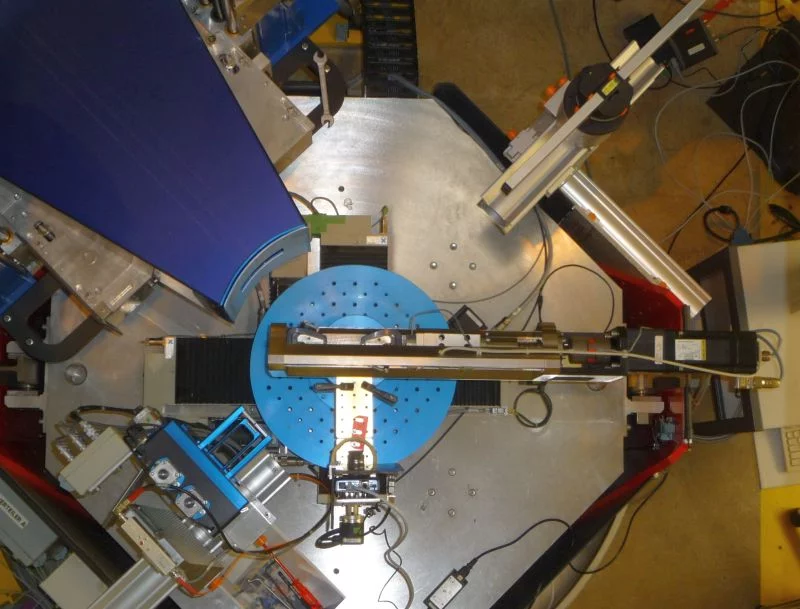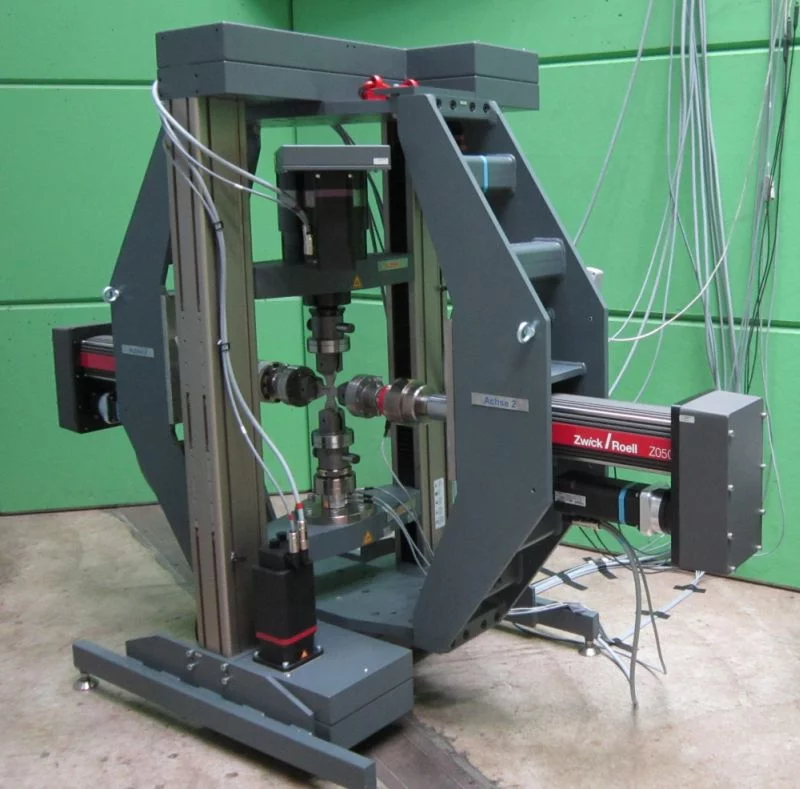Neutron diffraction is particulary well suited for the study of deformation mechanisms in engineering materials. In single phase materials the behavior of the different grain families give insight in the complex interplay between elastic and plastic anisotropy. In multiphase materials the load transfer between the phases is of particular importance. Other interesting applications include the study of the kinetics of phase transformations and the development of intra-granular strain during plastic deformation.
Uniaxial deformation is the most widely used mechanical test procedure for metals. For this purpose at POLDI there is a 30kN deformation rig which can be used for tensile/compression/low cycle fatigue experiments.
Many applications of metals involve complex strain paths, calling for devices that can apply multiaxial loading conditions. At POLDI a new multi-axial deformation rig (Zwick Roell) has been recently installed (Acta Materialia 105 (2016) 404-416). It allows performing in-situ in-plane biaxial loading along two orthogonal axes or combining uni-axial tensile/compressive deformation with torsion.
Uniaxial deformation is the most widely used mechanical test procedure for metals. For this purpose at POLDI there is a 30kN deformation rig which can be used for tensile/compression/low cycle fatigue experiments.
Many applications of metals involve complex strain paths, calling for devices that can apply multiaxial loading conditions. At POLDI a new multi-axial deformation rig (Zwick Roell) has been recently installed (Acta Materialia 105 (2016) 404-416). It allows performing in-situ in-plane biaxial loading along two orthogonal axes or combining uni-axial tensile/compressive deformation with torsion.
Main publications
Stresses and Strains in Cruciform Samples Deformed in Tension
Upadhyay M V, Panzner T, Van Petegem S, Van Swygenhoven H
Experimental Mechanics 57, 905-920 (2017).
DOI: 10.1007/s11340-017-0270-6
In-situ neutron diffraction during biaxial deformation
Van Petegem S, Wagner J, Panzner T, Upadhyay M V, Trang T T T, Van Swygenhoven H
Acta Materialia *10*5, 404-416 (2016).
DOI: 10.1016/j.actamat.2015.12.015
Study of lattice strain evolution during biaxial deformation of stainless steel using a finite element and fast Fourier transform based multi-scale approach
Upadhyay MV, Van Petegem S, Panzner T, Lebensohn RA, Van Swygenhoven H
Acta Materialia 118, 28 (2016).
DOI: 10.1016/j.actamat.2016.07.028
Complex investigation of deformation twinning in gamma-TiAl by TEM and neutron diffraction
Beran P, Heczko M, Kruml T, Panzner T, Van Petegem S
Journal of the Mechanics and Physics of Solids 95, 647 (2016).
DOI: 10.1016/j.jmps.2016.05.004
On the origin of cementite diffraction peak broadening during tensile deformation at ambient temperatures
Weisser M A, Van Petegem S, Cervellino A, Van Swygenhoven H
International Journal of Plasticity 66, 138-144 (2015).
DOI: 10.1016/j.ijplas.2014.10.008
In-situ biaxial mechanical testing at the neutron time-of-flight diffractometer POLDI
Repper Julia, Niffenegger Markus, Van Petegem Steven, Wagner Werner, Van Swygenhoven Helena
Internation Conference on Residual Stresses 9 (ICRS 9) 768-769, 60-65 (2014).
DOI: 10.4028/www.scientific.net/MSF.768-769.60
Effect of microstructure anisotropy on the deformation of MAX polycrystals studied by in-situ compression combined with neutron diffraction Guitton
A, Van Petegem S, Tromas C, Joulain A, Van Swygenhoven H, Thilly L
Applied Physics Letters 104, 241910 (2014).
DOI: 10.1063/1.4884601
Origin of localized rafting in Ni-based single crystal turbine blades before service and its influence on the mechanical properties
Pierret S, Etter T, Evans A, Van Swygenhoven H
Acta Materialia 61, 1478-1488 (2013).
DOI: 10.1016/j.actamat.2012.11.024
Neutron and X-ray diffraction study of residual and internal stress evolution in pearlitic steel during cold drawing
M Kriska, J Tacq, K Van Acker, M Seefeldt, S Van Petegem
5th European Conference on Neutron Scattering 340, 012101 (2012).
In situ room temperature tensile deformation of a 1% CrMoV bainitic steel using synchrotron and neutron diffraction
MA Weisser, AD Evans, S Van Petegem, SR Holdsworth, H Van Swygenhoven
Acta Materialia 59, 4448 (2011).
Plasticity of nanostructured Cu-Nb-based wires: Strengthening mechanisms revealed by in situ deformation under neutrons
V Vidal, L Thilly, S Van Petegem, U Stuhr, F Lecouturier, PO Renault, H Van Swygenhoven
Scripta Materialia 60, 171 (2009).
POLDI: Materials Science and Engineering Instrument at SINQ
A Evans, S Van Petegem, H Van Swygenhoven
Neutron News 20 (3), 17 (2009).
In situ Neutron Diffraction Study of Internal Micro-Stresses Developed by Plastic Elongation in < 110 > Textured BCC Wires
JG Sevillano, J Alkorta, D Gonzalez, S Van Petegem, U Stuhr, H Van Swygenhoven
Advanced Engineering Materialis 10, 951 (2008).
Plasticity of multiscale nanofilamentary Cu/Nb composite wires during in situ neutron diffraction: Codeformation and size effect.
V. Vidal, L. Thilly, S. Van Petegem, U. Stuhr, F. Lecouturier, P. O. Renault, and H. Van Swygenhoven.
Applied Physics Letters 88, 191906 (2006)
Upadhyay M V, Panzner T, Van Petegem S, Van Swygenhoven H
Experimental Mechanics 57, 905-920 (2017).
DOI: 10.1007/s11340-017-0270-6
In-situ neutron diffraction during biaxial deformation
Van Petegem S, Wagner J, Panzner T, Upadhyay M V, Trang T T T, Van Swygenhoven H
Acta Materialia *10*5, 404-416 (2016).
DOI: 10.1016/j.actamat.2015.12.015
Study of lattice strain evolution during biaxial deformation of stainless steel using a finite element and fast Fourier transform based multi-scale approach
Upadhyay MV, Van Petegem S, Panzner T, Lebensohn RA, Van Swygenhoven H
Acta Materialia 118, 28 (2016).
DOI: 10.1016/j.actamat.2016.07.028
Complex investigation of deformation twinning in gamma-TiAl by TEM and neutron diffraction
Beran P, Heczko M, Kruml T, Panzner T, Van Petegem S
Journal of the Mechanics and Physics of Solids 95, 647 (2016).
DOI: 10.1016/j.jmps.2016.05.004
On the origin of cementite diffraction peak broadening during tensile deformation at ambient temperatures
Weisser M A, Van Petegem S, Cervellino A, Van Swygenhoven H
International Journal of Plasticity 66, 138-144 (2015).
DOI: 10.1016/j.ijplas.2014.10.008
In-situ biaxial mechanical testing at the neutron time-of-flight diffractometer POLDI
Repper Julia, Niffenegger Markus, Van Petegem Steven, Wagner Werner, Van Swygenhoven Helena
Internation Conference on Residual Stresses 9 (ICRS 9) 768-769, 60-65 (2014).
DOI: 10.4028/www.scientific.net/MSF.768-769.60
Effect of microstructure anisotropy on the deformation of MAX polycrystals studied by in-situ compression combined with neutron diffraction Guitton
A, Van Petegem S, Tromas C, Joulain A, Van Swygenhoven H, Thilly L
Applied Physics Letters 104, 241910 (2014).
DOI: 10.1063/1.4884601
Origin of localized rafting in Ni-based single crystal turbine blades before service and its influence on the mechanical properties
Pierret S, Etter T, Evans A, Van Swygenhoven H
Acta Materialia 61, 1478-1488 (2013).
DOI: 10.1016/j.actamat.2012.11.024
Neutron and X-ray diffraction study of residual and internal stress evolution in pearlitic steel during cold drawing
M Kriska, J Tacq, K Van Acker, M Seefeldt, S Van Petegem
5th European Conference on Neutron Scattering 340, 012101 (2012).
In situ room temperature tensile deformation of a 1% CrMoV bainitic steel using synchrotron and neutron diffraction
MA Weisser, AD Evans, S Van Petegem, SR Holdsworth, H Van Swygenhoven
Acta Materialia 59, 4448 (2011).
Plasticity of nanostructured Cu-Nb-based wires: Strengthening mechanisms revealed by in situ deformation under neutrons
V Vidal, L Thilly, S Van Petegem, U Stuhr, F Lecouturier, PO Renault, H Van Swygenhoven
Scripta Materialia 60, 171 (2009).
POLDI: Materials Science and Engineering Instrument at SINQ
A Evans, S Van Petegem, H Van Swygenhoven
Neutron News 20 (3), 17 (2009).
In situ Neutron Diffraction Study of Internal Micro-Stresses Developed by Plastic Elongation in < 110 > Textured BCC Wires
JG Sevillano, J Alkorta, D Gonzalez, S Van Petegem, U Stuhr, H Van Swygenhoven
Advanced Engineering Materialis 10, 951 (2008).
Plasticity of multiscale nanofilamentary Cu/Nb composite wires during in situ neutron diffraction: Codeformation and size effect.
V. Vidal, L. Thilly, S. Van Petegem, U. Stuhr, F. Lecouturier, P. O. Renault, and H. Van Swygenhoven.
Applied Physics Letters 88, 191906 (2006)

